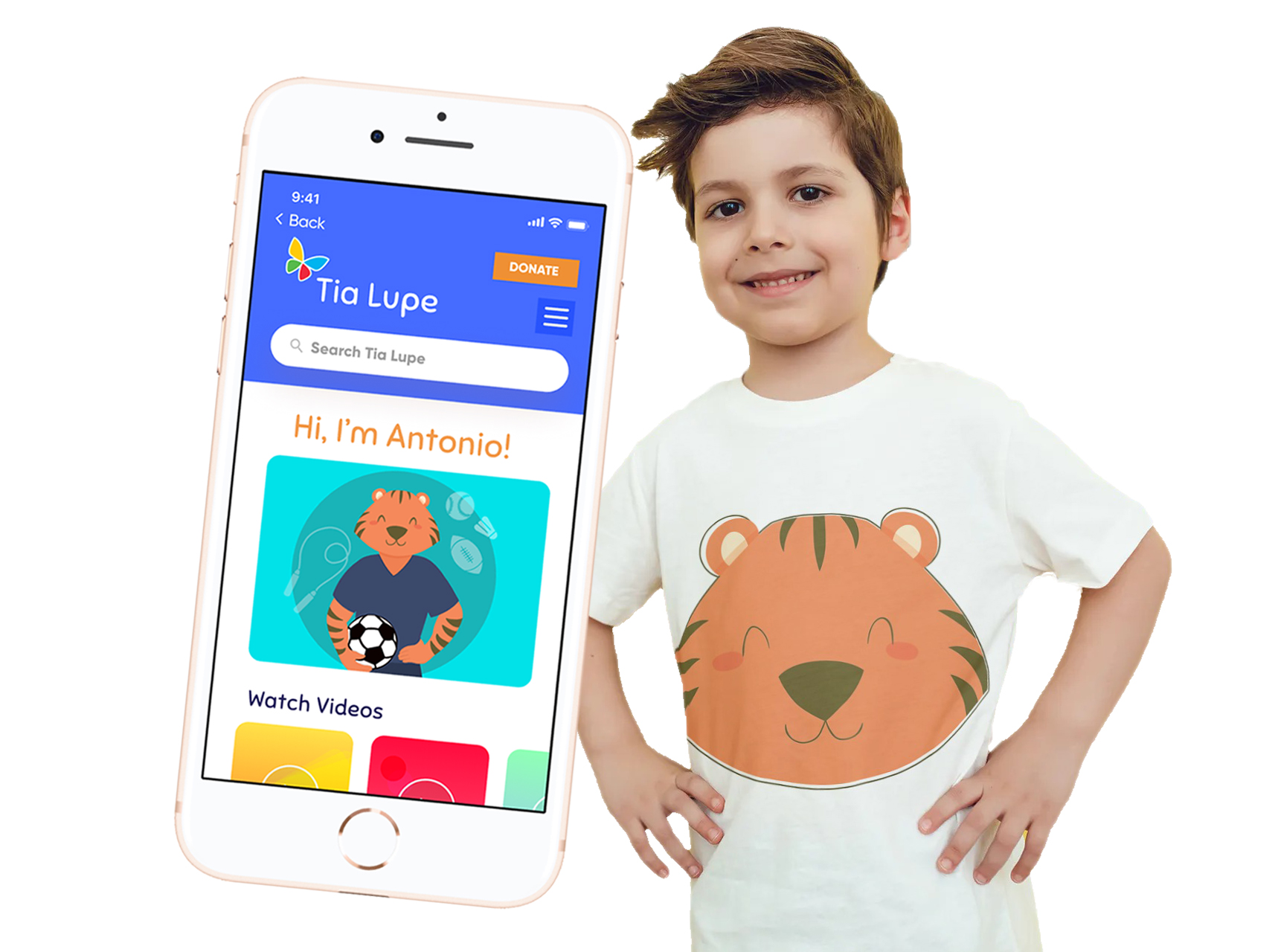Tia Lupe
A narrative-based healthcare web app that teaches Latinx parents and children about preventative care and resources via delightful personalized storytelling.
Client
Children's Hospital of Los Angeles
Context
A collaboration and educational partnership between Children’s Hospital of Los Angeles’ innovation lab and our IxD program.
The VISION is to create a trusted digital platform for Latinx patients, families, and their care team to work together to mitigate the effects of Social and Emotional Determinants of Health (SEDOH) to their health and wellbeing.
The brief's theme was “Design a Central Source to Community Resources.”
Children's Hospital of Los Angeles
Context
A collaboration and educational partnership between Children’s Hospital of Los Angeles’ innovation lab and our IxD program.
The VISION is to create a trusted digital platform for Latinx patients, families, and their care team to work together to mitigate the effects of Social and Emotional Determinants of Health (SEDOH) to their health and wellbeing.
The brief's theme was “Design a Central Source to Community Resources.”
My Role
- UX Research
- UI Design
- Usability testing
- Illustration Design
- Video Editing
Duration
February - June 2020
- UX Research
- UI Design
- Usability testing
- Illustration Design
- Video Editing
Duration
February - June 2020
Design Goal
This study aims to provide health systems and Latinx patients with a user-centered, easily accessible, and clinically validated tool to support the Hispanic and Latino Americans as the fastest-growing demographic group in the states. Our ultimate goal is to conduct an end-to-end research and design process incubating a better digital health solution focused on preventive care and the social determinants of health, especially for underserved and non-English speaking Latinx families and their children.
This study aims to provide health systems and Latinx patients with a user-centered, easily accessible, and clinically validated tool to support the Hispanic and Latino Americans as the fastest-growing demographic group in the states. Our ultimate goal is to conduct an end-to-end research and design process incubating a better digital health solution focused on preventive care and the social determinants of health, especially for underserved and non-English speaking Latinx families and their children.
What is the Problem?
The Latinx population in the U.S. is disproportionately impacted by SEDOH. This results in avoidable increases to the cost of healthcare. Many
technological
solutions exist to mitigate SEDOH, but none target the Latinx population.


So︎How might we use storytelling to inform Latina/o/x families about CHLA's preventative resources in a personalized way?
Research
Stakeholder
& Domain Experts
![]()

In order to
get the lay of the land, we started with secondary research and gathered even more valuable information about the project parameters from the field experts by interviewing Eric Meyer and Kelly Crown.
Here are some important terms we learned:
Latinx is used instead of Latino or Latina to refer to people of Latin American culture.
Tia Lupe is a mission at CHLA teaching Latinx families about preventative care and provides resources based on needs.
Promotor(a) is a person who is a trusted member of and who has an exceptionally close understanding of the community served in the delivery of health-related services through either working directly with providers or their partner organizations.
SEDOH (Socio-Economic Determinants of Health) Health is influenced by five broad categories known as determinants of health: genetics, behavior, environmental and physical influences, medical care, and social factors.
![]()
Guadalupe works as a Promotora at CHLA providing health education and better service in her community. She explained to us about the way she uses her personal story to earn the trust of, relate to and forge stronger relationships with the families she works with. “The patients come from different backgrounds so it’s hard for them to open up to just anybody. It’s important for them to feel that I’ve been in the same position they have.”
![]()
Dr. Andrade is a Communication Studies professor, and his research focuses on Latinx student education and intercultural communication. Based on his personal experience, he believes that parents and teachers working together as partners through a storytelling approach represents the best way to help Latinx students succeed, as he stated here, “Storytelling is a powerful tool for communication. It can be used to influence and connect with people.”
Dan, a senior software engineer at Honey Inc. advised us to consider creating the educational platform as a web app due to the reduced amount of development cost as well as time necessary to develop the app. Ali from CHLA Innovation studio team also mentioned that many Latinx patients prefer to use their phones to browse the internet, and having the app live on the CHLA website would allow them to have easier access to the information it contains.
Here are some important terms we learned:
Latinx is used instead of Latino or Latina to refer to people of Latin American culture.
Tia Lupe is a mission at CHLA teaching Latinx families about preventative care and provides resources based on needs.
Promotor(a) is a person who is a trusted member of and who has an exceptionally close understanding of the community served in the delivery of health-related services through either working directly with providers or their partner organizations.
SEDOH (Socio-Economic Determinants of Health) Health is influenced by five broad categories known as determinants of health: genetics, behavior, environmental and physical influences, medical care, and social factors.

Guadalupe works as a Promotora at CHLA providing health education and better service in her community. She explained to us about the way she uses her personal story to earn the trust of, relate to and forge stronger relationships with the families she works with. “The patients come from different backgrounds so it’s hard for them to open up to just anybody. It’s important for them to feel that I’ve been in the same position they have.”
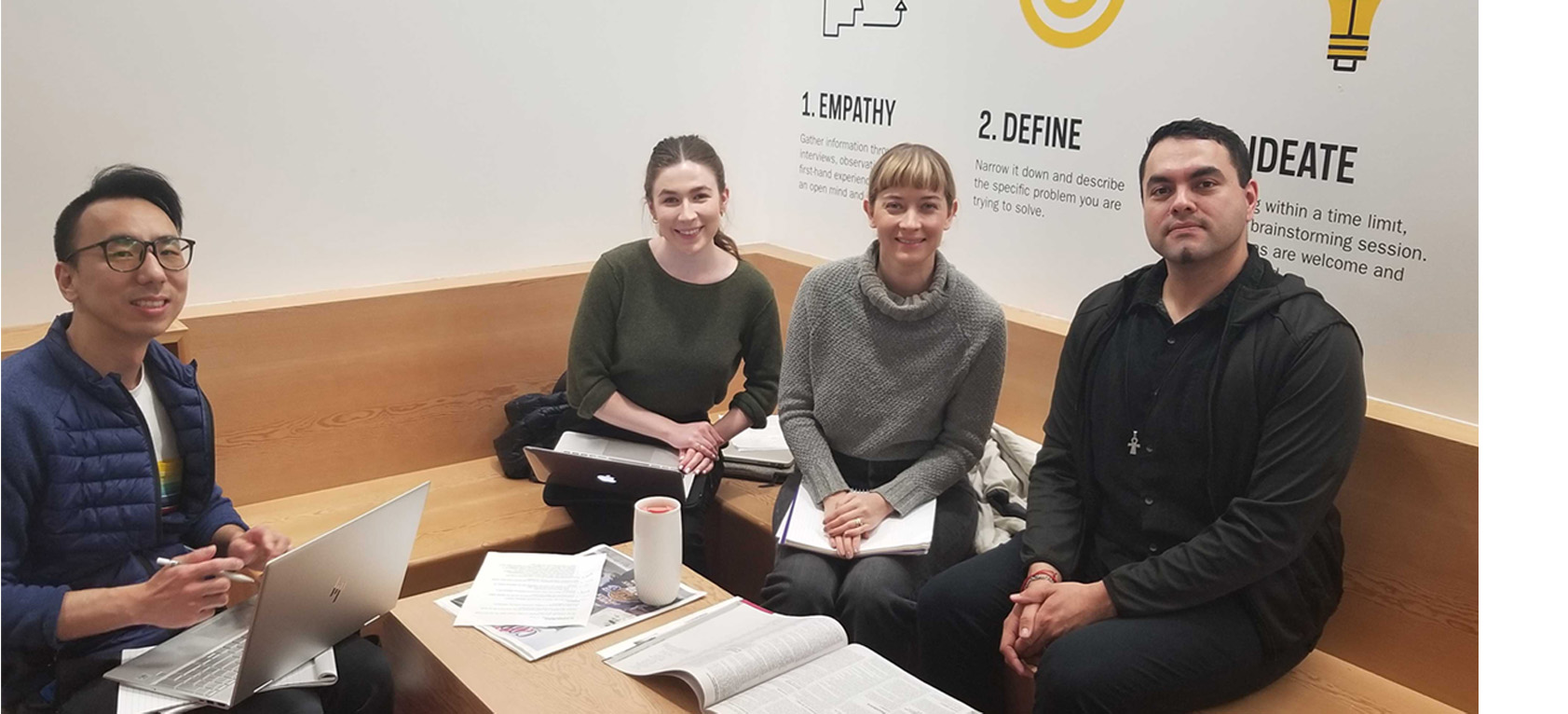
Dr. Andrade is a Communication Studies professor, and his research focuses on Latinx student education and intercultural communication. Based on his personal experience, he believes that parents and teachers working together as partners through a storytelling approach represents the best way to help Latinx students succeed, as he stated here, “Storytelling is a powerful tool for communication. It can be used to influence and connect with people.”
Dan, a senior software engineer at Honey Inc. advised us to consider creating the educational platform as a web app due to the reduced amount of development cost as well as time necessary to develop the app. Ali from CHLA Innovation studio team also mentioned that many Latinx patients prefer to use their phones to browse the internet, and having the app live on the CHLA website would allow them to have easier access to the information it contains.
 Eric Meyer
Eric MeyerInnovation Strategist
 Kelly Crown Innovation Consultant
Kelly Crown Innovation Consultant Guadalupe Eaton
Promotora at CHLA
Guadalupe Eaton
Promotora at CHLA
 Dr. Luis Andrade
Communication Studies professor
Dr. Luis Andrade
Communication Studies professor
 Dan Jeffery
Senior Software Engineer
Dan Jeffery
Senior Software Engineer
Ali Arnett
Innovation Program Admin
Desk research
![]()
![]()
![]()
![]()
![]()
![]()
![]()
![]()
![]()
Conceptualization
We combined several ideas to develop in more detail into a well-conceived concept poster in order to provide a roadmap for future thinking.
![]()
![]()
![]()
![]()
Persona
The mother(Juliana) and son(Luka) are the two personas we created to respond to the question “Who do we design for?” It reminds us of the users’ needs and helps us create a better user experience model.
![]()
![]()
Journey Maps
We created two-user journey maps to visualize how Juliana and Luke discover and interact with the current and future processes of accessing CHLA resources, and how they feel along the way based on two completely different experiences.
![]()
![]()
Stakeholder Map
Our stakeholder map reveals the relationship between Latinx community patients and the CHLA healthcare system. It helps to understand who the stakeholders get involved in the ecosystem.
![]()
![]()
Narrative Health
“Narrative health asks us to thoughtfully examine who is telling a story and how they are telling the story (with a focus on WHO is defining health and HOW), to listen intentionally, and to share stories both between and within communities.” -- EmmaLee Pallai, MFA; Kim Tran, PharmD
“Narrative health asks us to thoughtfully examine who is telling a story and how they are telling the story (with a focus on WHO is defining health and HOW), to listen intentionally, and to share stories both between and within communities.” -- EmmaLee Pallai, MFA; Kim Tran, PharmD

Promoting Health Literacy Through Storytelling
1. Responsibility to ensure patients understand what they need
2. The Issue is how consumers access and process the information
3. Storytelling individualizes patient teaching and promotes health
“Storytelling allows hearers to reflect on the story told and actively apply it to their life situation.” -- Vivian Day, BSHCA, MHA, RN
1. Responsibility to ensure patients understand what they need
2. The Issue is how consumers access and process the information
3. Storytelling individualizes patient teaching and promotes health
“Storytelling allows hearers to reflect on the story told and actively apply it to their life situation.” -- Vivian Day, BSHCA, MHA, RN
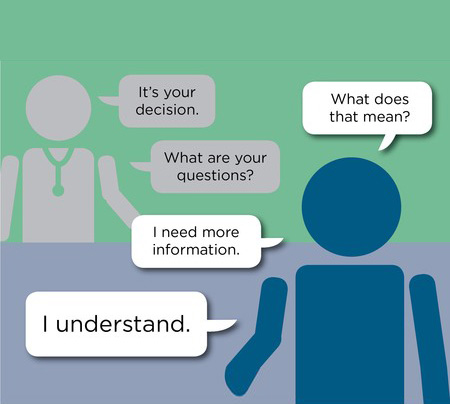
Designing for Diabetes
Latinx Americans and Type 2 Diabetes
︎︎More than half of Latina/o/x American adults are expected to develop type 2 diabetes in their lifetime.
Childhood Diabetes Risks
︎︎Latinx children and teens are at higher risk for type 2 diabetes too(Genetics, Food, Weight, and activity).
CHLA Diabetes & Obesity Program
︎︎ Treating 2,000+ patients annually for type-1 and type-2 Diabetes. -- Diabetes and Obesity Program | CHLA
Latinx Americans and Type 2 Diabetes
︎︎More than half of Latina/o/x American adults are expected to develop type 2 diabetes in their lifetime.
Childhood Diabetes Risks
︎︎Latinx children and teens are at higher risk for type 2 diabetes too(Genetics, Food, Weight, and activity).
CHLA Diabetes & Obesity Program
︎︎ Treating 2,000+ patients annually for type-1 and type-2 Diabetes. -- Diabetes and Obesity Program | CHLA

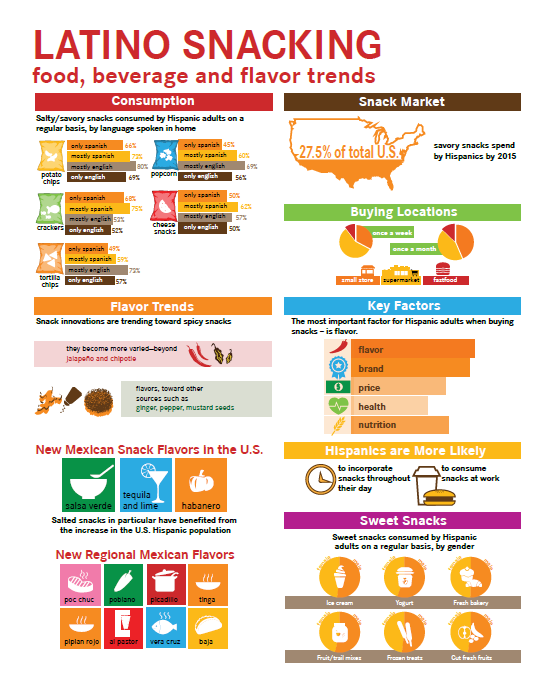

Digital Storytelling for Latina/o/x Diabetes Patients
“Digital storytelling interventions for chronic diseases, such as diabetes may be especially powerful among immigrants because often limited English proficiency minimizes access to and affects the applicability of the existing health education opportunities.” -- Stories For Change
“Digital storytelling interventions for chronic diseases, such as diabetes may be especially powerful among immigrants because often limited English proficiency minimizes access to and affects the applicability of the existing health education opportunities.” -- Stories For Change

Ideation
In our ideation phase, we began brainstorming and
sketching ideas on sticky notes and whiteboards to help us generate ideas, narrow down the scope, and refine our understanding of the service. To continue and enrich the ideation process, we then created the concept poster, stakeholder system maps, journey maps, and personas in order to reframe and optimize an innovative solution that targets all customer touchpoints.



Conceptualization
We combined several ideas to develop in more detail into a well-conceived concept poster in order to provide a roadmap for future thinking.



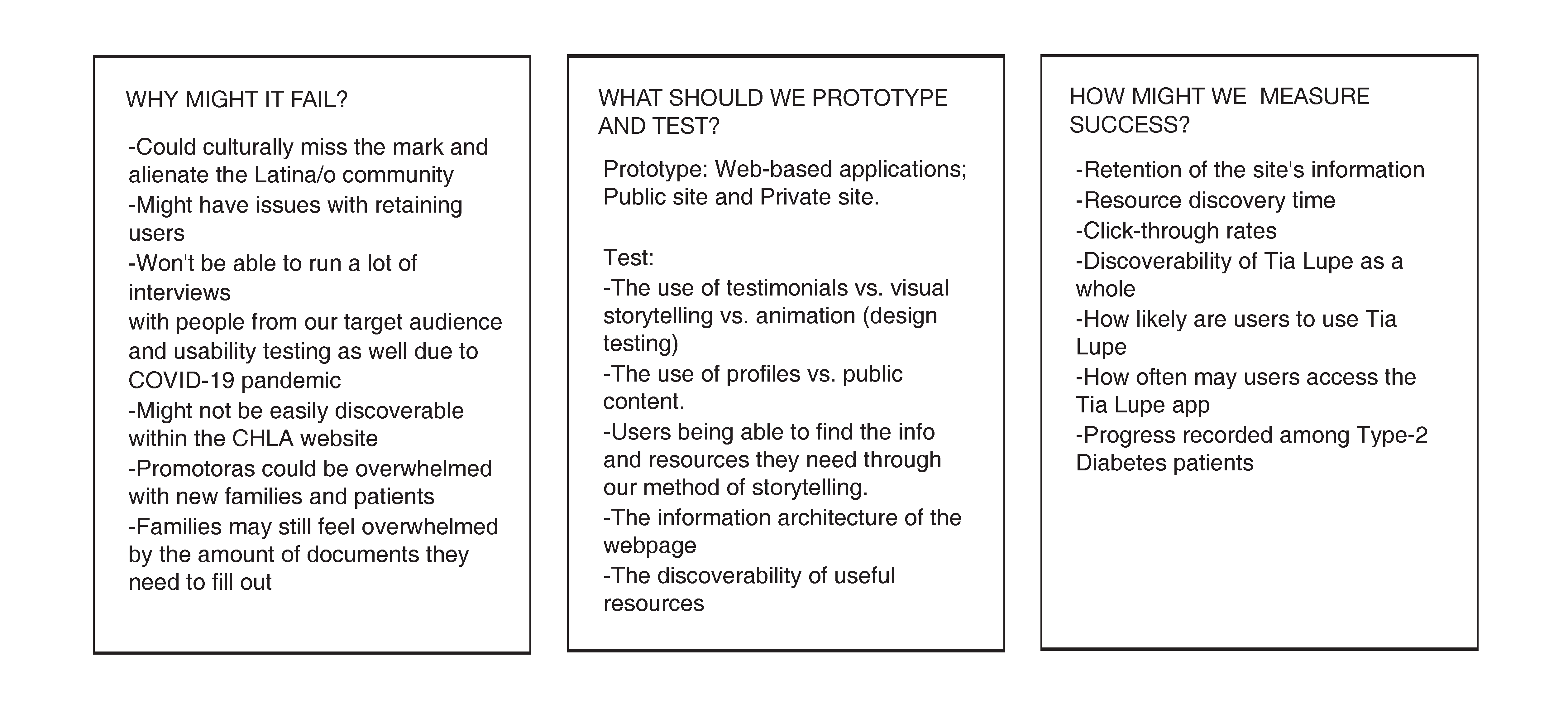
Persona
The mother(Juliana) and son(Luka) are the two personas we created to respond to the question “Who do we design for?” It reminds us of the users’ needs and helps us create a better user experience model.


Journey Maps
We created two-user journey maps to visualize how Juliana and Luke discover and interact with the current and future processes of accessing CHLA resources, and how they feel along the way based on two completely different experiences.


Stakeholder Map
Our stakeholder map reveals the relationship between Latinx community patients and the CHLA healthcare system. It helps to understand who the stakeholders get involved in the ecosystem.
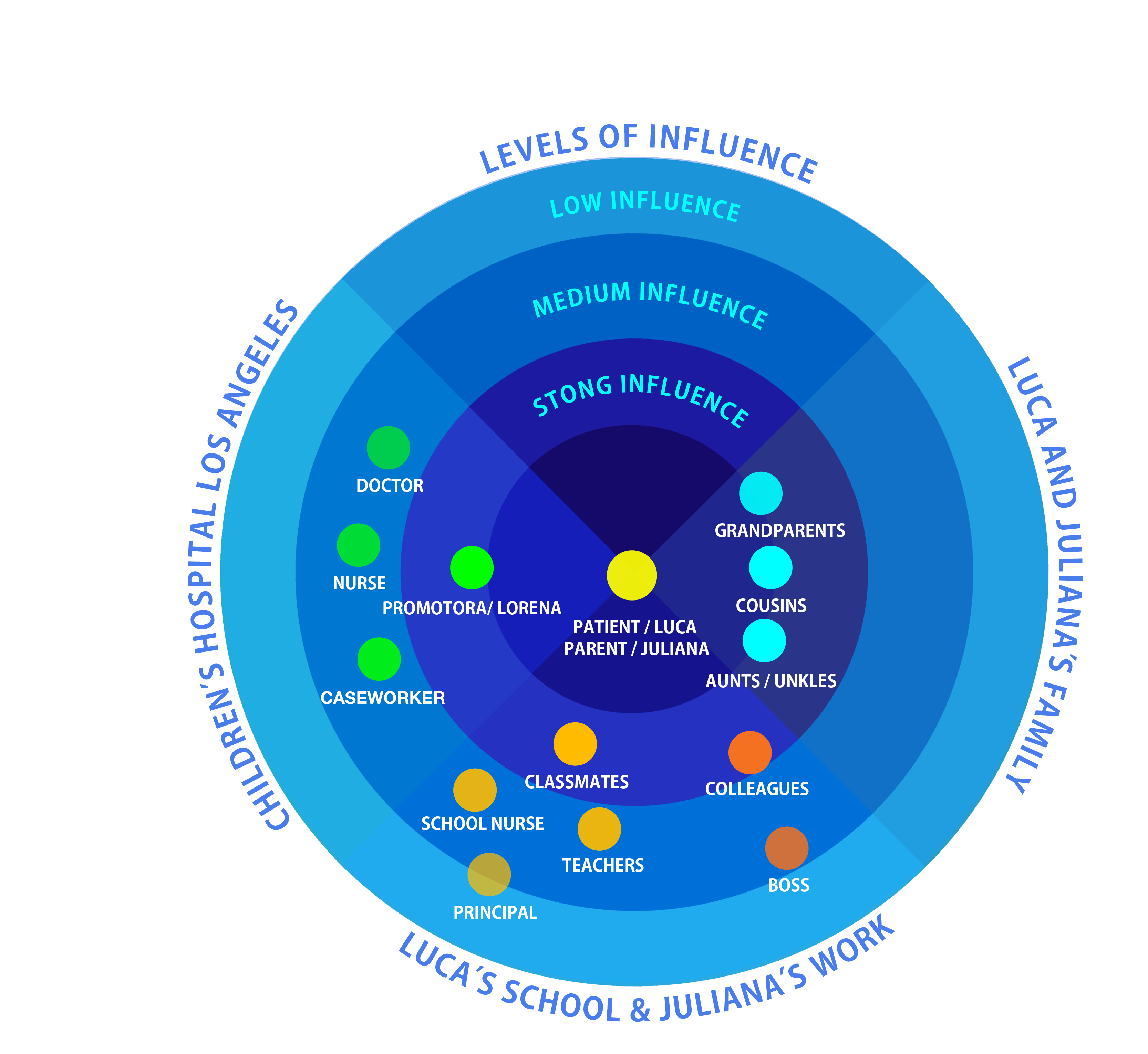
System Map
We finally created a system map as a synthetic representation to demonstrate how we deliver excellent customer service helping CHLA and patients get connected through Tia Lupe.
We finally created a system map as a synthetic representation to demonstrate how we deliver excellent customer service helping CHLA and patients get connected through Tia Lupe.

Prototype
Wireframes
Tia Lupe is a web application that lives on the CHLA website. It provides separate resources for parents and children based on their conditions. Therefore, we designed our wireframes on a large scale through which we are aiming to improve both parents and children to access healthcare resources when they need them. Given our team's time and physical constraints, we decided to focus on the highlighted children’s side of Tia Lupe.

User Interface
The web application
links to CHLA's homepage where patients as well as hospital staff would easily
find and access Tia Lupe. Based on our research, we found that choosing to use
Type-2 Diabetes as an example to demonstrate how to navigate the app was more
relatable and efficient for the purpose of our app.
CHLA - Home Page

Tia Lupe - Loading Page

Tia Lupe - Home Page

Tia Lupe Kids - Home Page
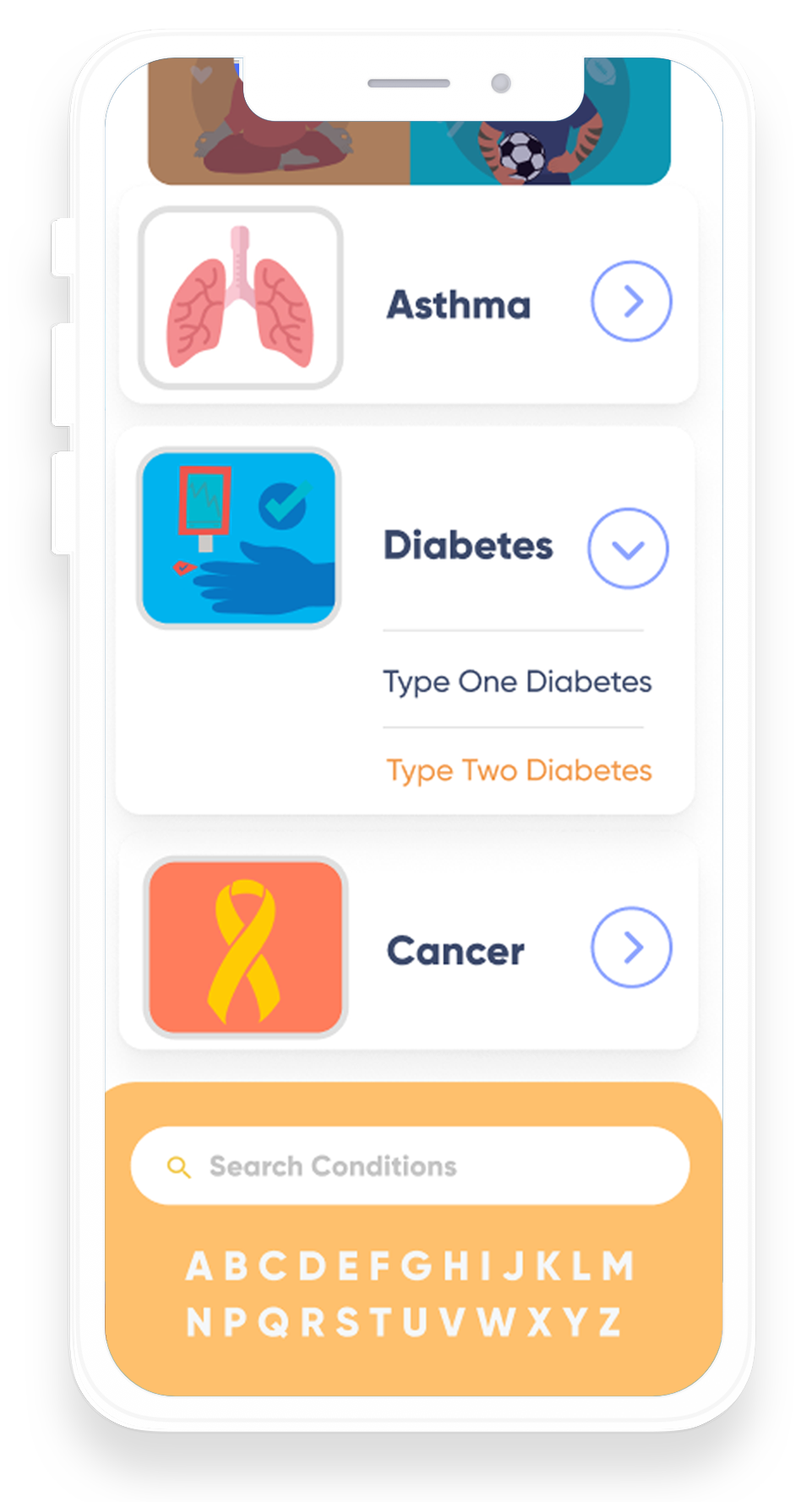
We understand that cognitively children are very different from adults. Through research, we found that designing a kid-friendly app with playful user interface and character-driven navigation was the best way to empower children and make them feel motivated to use the app. Therefore, we created and developed 4 cute cartoon animal characters aiming to educate and inspire children to make healthier choices and changes in order to support their health and overall wellness. Each character uses his/her own expertise to help facilitate the learning process.
Tia Lupe Kids - Home Page
![]()
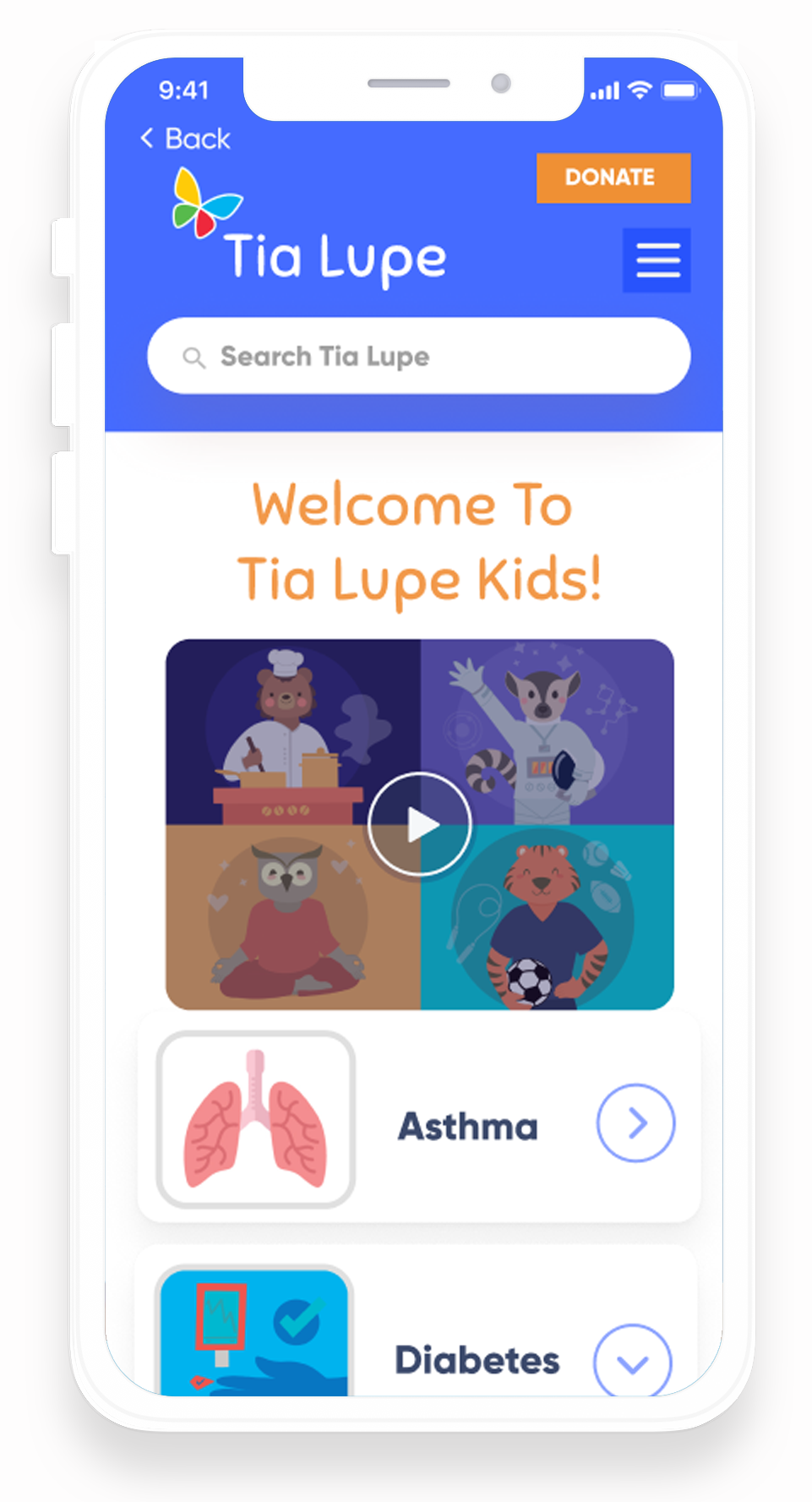
Tia Lupe Kids -
Character/Maria
![]()

Tia Lupe Kids -
Character/Antonio
![]()


Tia Lupe Kids - Character Design
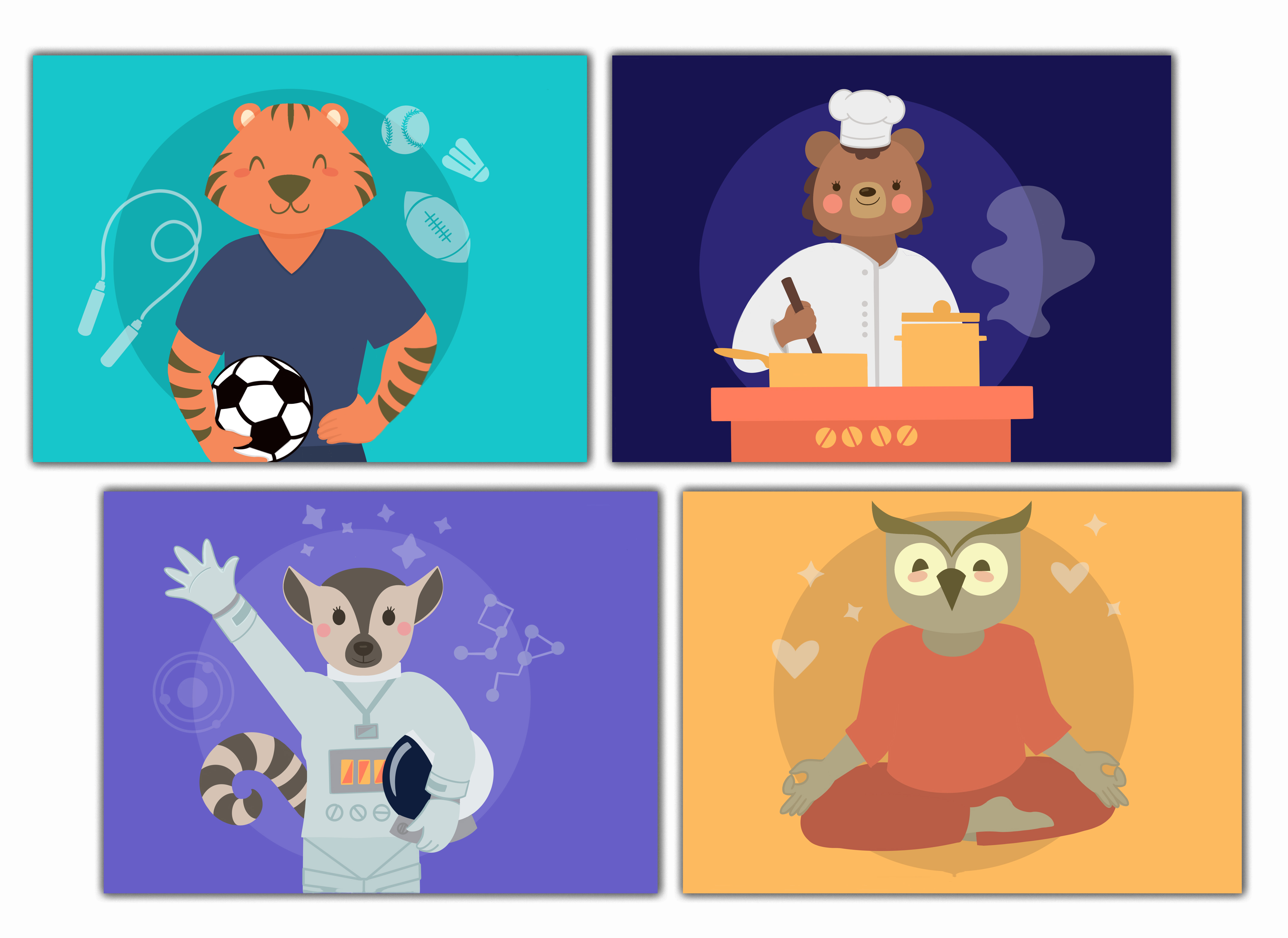
Our high-fidelity prototypes include 4 key sections, Video, Gaming, Activities, and Printable. Here, children with Type 2 Diabetes learn about preventative care and disease management throughout delightful personalized storytelling, informative testimonials, and child-focused educational narratives.
Ultimately, our goal is to help children use the interface successfully by ensuring that all the designs and content display clear and specific instructions as well as prior educational information that together are intended to elevate children’s confidence in managing their health conditions.
Type 2 Diabetes - Home Page

Type 2 Diabetes - Videos

Type 2 Diabetes -
Printables
![]()

Type 2 Diabetes - Games

Type 2 Diabetes - Activities
Type 2 Diabetes - Gamification Design | What to Eat?






Results
Usability Testing
The project was shifted online due to the COVID-19 pandemic. The Coronavirus outbreak did not only impact our lives and schoolwork but also caused difficulty and hardship getting in front of the users who agreed to test this product. With a great team effort, we managed to successfully pull through 2 rounds of remote prototype testing with 3 wonderful and cooperative users.
The project was shifted online due to the COVID-19 pandemic. The Coronavirus outbreak did not only impact our lives and schoolwork but also caused difficulty and hardship getting in front of the users who agreed to test this product. With a great team effort, we managed to successfully pull through 2 rounds of remote prototype testing with 3 wonderful and cooperative users.
Key Finding
1. The lemur was not as recognizable
2. Appropriate age-related resources and activities. e.g. Jumping rope for ages 5-8 and playing soccer for ages 9-12
3. Text was found to be heavy for children ages 5-8
4. The game was fun. Some issues around recognizing foods
1. The lemur was not as recognizable
2. Appropriate age-related resources and activities. e.g. Jumping rope for ages 5-8 and playing soccer for ages 9-12
3. Text was found to be heavy for children ages 5-8
4. The game was fun. Some issues around recognizing foods
CHLA Feedback
1. Focus on one age group for the kids section, and curate the content based on that age’s needs
2. Consider how content would change depending on different age group
3. Think about designing and showing the whole structure of Tia Lupe, including the parent site
4. More private functions and information could be offered through a CHLA patient portal
5. Explore more food resources, such as grocery list calculators and Fast Food order guides
6. There could be a need for a supplementary physical product, such as printables and stuffed toys
1. Focus on one age group for the kids section, and curate the content based on that age’s needs
2. Consider how content would change depending on different age group
3. Think about designing and showing the whole structure of Tia Lupe, including the parent site
4. More private functions and information could be offered through a CHLA patient portal
5. Explore more food resources, such as grocery list calculators and Fast Food order guides
6. There could be a need for a supplementary physical product, such as printables and stuffed toys
1st round of testing - Zhen, 6 Years old
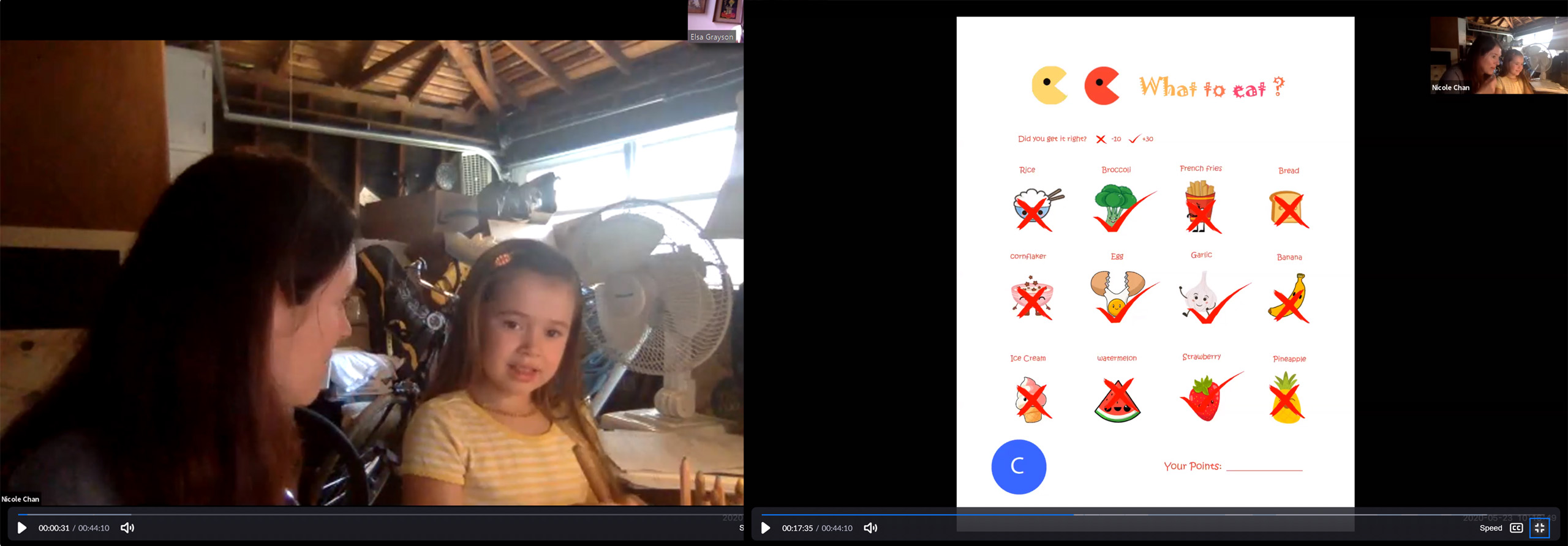
2nd round of testing - Joey, 7 & Maverick, 5.

CHLA Final Presentation

Reflection
Our Tia Lupe project was shifted online approximately 2 weeks after the COVID-19 quarantine started. We were forced to work on the project from home for the rest semester. Being in isolation and living in lockdown is definitely new and challenging for us. However, as UX designers, we certainly benefited from our design-thinking mindset by quickly adopting and developing an effective remote-work strategy to move the project forward. We communicated via Slack messages and scheduled Zoom meetings almost every day to continue exchanging ideas and working as a team. We kept updating delivery plans and set the work ahead to coordinate our project via Google Calendar and Monday.com. We collaborated via tools like Trello, UXPressia, Balsamiq, Figma, and Google Drive to keep design creativity fresh and to support working remotely together. The hard work and effort have paid off. Our final presentation was well-received and praised by the CHLA team. I'm so proud of our team for being able to keep the mood up and staying productive under quarantine. I thank my professors and cohort, for their contribution to the project. We did produce an excellent case study during a difficult time, and we did it together.
Future Considerations
1. Test the app with different age groups, such as Ages 8-12
2. Redesign Lemur character as a monkey
3. Instead of text-based design try to add more images, illustrations and videos to the content
4. Redesign the app in Spanish
5. Test the app with Spanish speaking families
Future Considerations
1. Test the app with different age groups, such as Ages 8-12
2. Redesign Lemur character as a monkey
3. Instead of text-based design try to add more images, illustrations and videos to the content
4. Redesign the app in Spanish
5. Test the app with Spanish speaking families
